Unveiling the Journey
Introduction
The study is all about "experiences of young people diagnosed with HIV 18-24-year-olds". As young adults, it becomes quite an unacceptable case of being diagnosed with such a disease. They become morally imbalanced while they face discrimination. Their entire life cycle is changed while they fall prey to such a disease. An introduction towards the management of such a disease is not done in many parts of the world. The awareness is not spread adequately and this becomes a reason for discrimination among students. It also encourages a wide range of components of treating the younger adults with this disease. For those seeking healthcare dissertation help, understanding the availability of various treatments and early diagnosis is crucial in addressing these issues. Wide varieties of treatments are available nowadays that can save precious lives if diagnosed early. In today's world the rural parts of Africa, Asia is mostly diagnosed with this disease. This occurs due to unawareness of the reasons that are causing this disease and not knowing why and how the spread occurs.
Rationale
The research question is chosen for the identification of experiences of young people that are diagnosed with HIV and belong to the age group of 18 to 24 years old. The research topic is justified since the issue is identified to be a burning one. Many people are becoming demoralized when they hear the news of being a patient of HIV (Akram et al. 2018). The transmission occurrence needs to be stopped and by breaking the chain of spread a person’s life can be changed. The topic gives an idea on young adults of age group 18-24 years are facing discrimination due to this disease.

There is a wide range of literature available that focuses on such issues. It becomes important to analyze them to manage the people's lives that are suffering from mental depression and dilemmas because of such a disease. Certain actions are required to be taken to manage the critical appraisal components.
Importance of integrative review of literature
An integrative literature review is important as the actions are taken for the people in need define their future. In a learning environment, a critical review of literature integrates the actions that would be taken for HIV patients of certain age groups (Chimbindi et al. 2020). It is not easy to live with HIV as society is always trying to discriminate against the people being diagnosed. Spreading awareness and taking the right steps in mitigating such disease is utterly important in this situation. “Where and how do young People Like to Get their Sexual and Reproductive Health Information”, is a matter of concern. Young people often face several psychological and mental health challenges that are observed for creating support systems for aiding the people. Here a discussion will be provided upon “Antiretroviral Therapy Based HIV Prevention Targeting Young Female-Sex Workers". Several community-based programs are helpful in the management of HIV. 18-24-year-olds with life-limiting conditions are the focus of this study. Social applications can be created that will help in risk management and protect people from the stigma of HIV-related people.
2. Literature Review
Research Question
The research question is formulated using internal and external sources and information gathering from different secondary sources. The questions are: Primary research question:
What are the experiences of young people diagnosed with HIV 18-24-year-olds? Secondary research question:
How do young adults feel about discrimination while being diagnosed with HIV? Why are people unaware of the spreading process of HIV? How the stigma regarding HIV is becoming a failure of healthcare improvement?“Significant HIV disparities affect LGBTQ+ populations and medical mistrust from experiences of healthcare workers”. As explained by Guaraldi, and Palella, (2017), the differentiation of providing required treatment is required to be managed appropriately. Working with volunteer participants is important to formulate the research. The main research question here is the identification of how the younger adults are being treated in society while everyone comes to know about this life-threatening disease.
Search Strategy
The search strategy is qualitative which uses a secondary method to complete the search. In this case, the search keywords were related to HIV, young adults, stigma, and experiences. There were scholarly articles collected from trusted sources like Google Scholar. All research materials are coming up with appropriate citations. According to Helms et al. (2017), experiences of people living with HIV and the right issues are the maximum focus of the search. Students are not getting sex education enough from schools and other trusted mediums. It is considered taboo to talk about intercourses and sexual relationships with parents. Hence, they are practicing methods that are unprotected. This is leading to sexually transmitted diseases. Limited and misleading information on the internet regarding the process is becoming a threat to every 18-24 years old younger adult.
methods that are unprotected. This is leading to sexually transmitted diseases. Limited and misleading information on the internet regarding the process is becoming a threat to every 18-24 years old younger adult.
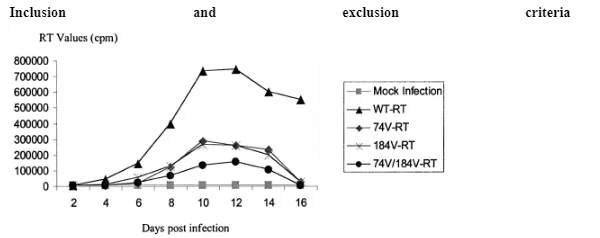
https://www.researchgate.net/figure/Growth-curve-of-HIV-1-replication-after-infection-of-MT-4-cells-by-viruses-harvested-from_fig2_10640175)
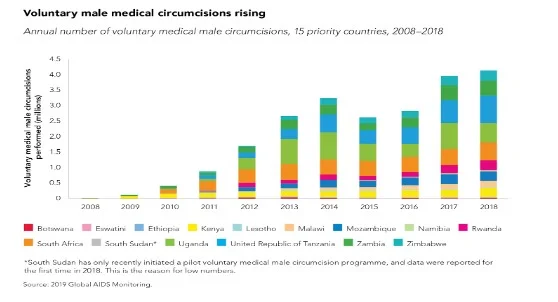
Inclusion criteria for the research are found out to be the ones that come with the tagline of "Psychosocial and mental health challenges faced by emerging adults living with HIV”, and the title of “Optimizing community-based HIV testing and linkage to care for young persons (Horter et al. 2019)". There are more criteria of "Experiences with stigma and discrimination among adolescents and young adults living with HIV" and identification of threats observed within the gain of the reproductive health system. Three components are maximized among which the specific ones are explained as (1) discretion, (2) being candid about testing, and (3) incentivizing testing. Inclusion criteria are based upon the dates above 2016. There is focus group testing that gives a clear idea of what is being thought by the participants. Exclusion criteria include journals below the date of 2016. Any patented information is not included. Any paid materials are not included and open sources activities are cited for information management.
Critical Appraisal of research design
The research design is identified to be qualitative and explanatory. Each stage is described with inductive data available to the researchers. All the data which is presented incorporates an overall arrangement of components along with the revival of aids related issues. HIV-positive people are sometimes financially unstable and they are concerned more (Johnson Shen et al. 2019). All possible methods of helping those people are discussed in this research which is identified as a strength of this research paper. There is positivity aligned as per the need of the hour and appropriate steps are taken to complete the research in terms of qualitative components.
Data Extraction Table
Theming table
Refer to appendix
3. Results
Unprotected intercourses and lack of awareness on HIV prevention
Unprotected intercourses are associated with a specific community that is aged between 18-24 years and is unaware of the facts of infection. HIV is identified to be a life-threatening disease that is occurring in most people these days and there is a lack of awareness observed regarding the disease (Jones et al. 2017). Unprotected sexual intercourse along with a lack of interest in using condoms for safety purposes becomes a threat to the people of the age group 18-24 years. There is the incompetence of government agencies observed in many parts of Asia and South Africa, which can protect younger adults from being indulged in unprotected sexual activities. Even though there are significant channels derived upon to work on such a disease, primary actions are not taken in most of the cases. As mentioned by Julg et al. (2019), data quality and credibility of research are influenced using a pragmatic analysis to find out the research companionship. In an ethical system, each young adult is expected to live freely and encourage participants to discuss their problems with elders. However, in the maximum case, the age group does not even get a chance to explain what is going wrong with them. It is also identified that the pilot short-break services are required for accessing the CYP service and recalling why and how the transmission of the disease is occurring. Recovering from a mental dilemma is important since the people in concern are in miserable conditions and their life has become limited. At the age of 18, a person might find it difficult to understand the diversification related to society (Kerr et al. 2021). An indulgence to adulthood concepts is important since all the younger people are getting information on sexual activities from different websites at an early stage.
Parents are relinquishing the factors of their child becoming stubborn and indulging in self-confinement once they find out that they are HIV positive. Here the role of society is important to be understood. Suitable mental home modules were also remaining undiscovered throughout this development of disease among adults. Decision-making also becomes a threat while delivering the services and living within a particular community (Kohli et al. 2020). "Professionals were aware that the name 'hospice’ can often make families and children feel apprehensive because of their preconceptions that a hospice is a place where people go to die”. Hence, the concept of sending younger adults to such places while they are diagnosed with HIV is not an option. This might lead to more mental damage than relief for that particular group.
Stigma related to HIV patients fuels discrimination and does not allows living a normal life
Digital engagement metrics are associated with a cut-through of linked advertisements on protection from aids has been ruling over the market. In most places, there is a certain level of stigma observed that demotivates HIV-positive patients. The patient in concern is the age group of 18-24 years who are having more exposure to the internet. As explained by Mathew et al. (2020), they are practicing unauthorized practices after learning from misleading internet advertising during intercourse. This is becoming one of the major threats of the decade and their partners are also becoming targeted for this particular threat. There are many people involved in the development of appropriate living conditions for every 18 to 24 years old. Several sex-seeking young adults are not following protocols for having safe sex. Moreover, there is no parental control observed in the group and they are exposed to this harsh world's reality. No significant relationships were associated with the improvement of health care components with the targeted groups. The fundraisers, NGOs are also concerned about children and elderly people while shifting focus from the target age group (Mcharo, Mayaud, and Msuya, 2020). As per sample collections and free test booking, many of these age groups are not asked to participate. Patients with an LGBTQ background are likely to become diagnosed with HIV while sexual health and well-being are not valued. The relationships between STD, HIV, and early pregnancies are not yet determined. Stigma regarding the participants' opinions and educational aspects has to be modified. Employment standards are being impacted while disclosing HIV status is done. People are ignorant to the fact that HIV is a disease that can only be transmitted through sexual relationships and not by working together or shaking hands or sharing food from the same plate (Murray et al. 2018). Moreover, appropriate disposal of HIV testing kits is often ignored which leads to a threat of spread if the same syringe is used on any other person.
A disclosure to aid in adherence to health issues including the treatment of transmission to sexual partners has been observed as a threat in healthcare. Once, there is a finalizing of components are done the discrimination is managed as early as possible. Basic demographic information sharing and checking the status of how the participants are feeling is not done quite often (Ning et al. 2020). In schools and the workplace, the stigma works highly and becomes a cause of fear among normal people. Total discrimination faced by the age group is impacting their future and need counseling to reform their lifestyles.
Threats of using social apps in younger adults resulting in HIV and unwanted pregnancy
Several threats have been observed within an application that encourages social dating or blind dating. Such an application allows younger adults to meet with new people and indulge in physical relationships. Any indulgence in a physical relationship becomes a chronic threat of stigma. Any efforts or strategies that identify the needs of younger adults are channelized to its core. The maximum allowance of interpersonal effectiveness and individual working conditions needs to be evaluated to its core. During some cross-sectional surveys, certain identification is done which describes the sexual behaviors among users. They are mostly in search of intimacy while they are not ready to jump into any sort of relationship. A moment of physical pleasure is becoming life-threatening for them. Some of the concerned age group people fall prey of sex-rackets and becomes a sex worker without their consent (Nyongesa et al. 2021). “HIV-related stigma and discrimination continue to be major social determinants driving the epidemic of HIV globally despite the advances in medical treatment". The age group in concern is mostly associated with substance use. Overexposure to drugs and alcohol is also becoming a threat to the communities. There are threatening working conditions that require to be analyzed highly. In case, patients are going out of control then certain management conditions should be applied. There are several reflective actions observed on LGBTQ+ patients and events are observed to the prevalence of STI management. There are examples of anal penetration that leads to bleeding and infections. Gradually this process leads towards discrimination between the people of concerned age groups highly in today's scenario.
“Professionals reported that they were concerned because they are working with an emerging group of young adults with life-limiting conditions that, until recently, would have died in childhood". The mental breakdown and suffering of the professional and personal dilemma are highly executed throughout the process of staffing. As mentioned by Reif et al. (2017), basic care and services are not always received and require the younger adults to follow protocol while having physical intercourse. It was observed that younger adults are having this medical threat as a growing national problem. The consensus among staff members was quite less while the young adults were treated with the issues and the taboo was raised eventually to a higher post. It also did not allow them to spend time with new ones with those younger adults being diagnosed with HIV. While there were adults found with a lack of regenerative conditions, it becomes a threat to not work out well. An association of young adult service commencement involves decision-making and gives appropriate options to engage themselves in treatments. Moreover, due to the physical taboo, there is a lack of staffing and financial services. An initiative was taken to encourage moving into hospital components. Attributes of nursing and non-nursing staff needs are also required to be focused while dealing with a life-threatening disease.
Incorporation of HIV awareness and right information sharing on sexual activities
Incorporation of HIV awareness is important as many of the target personnel are still unaware of the facts on how the spread is occurring. In a particular case, some services encourage limited places, limited availability, and limited equipment for HIV services. There are patients and staff members who need complete motivation to achieve success in their lives. Having younger adults engage in short break services is important since there are occupational threats growing and unemployment is increasing (Usman, and Usman, 2019). The emergence of not providing any emotional consideration is being a reason for young adults losing themselves and their life-limiting conditions are growing. The services are identified to be specialized in identifying HIV patients among a group of 100 or more young adults. Despite all the important people are confined in their prejudices and they are not ready to face the challenges that the world is bringing up to them. During the development of these services, there were social activities that gave tailor-made competency development and outweighing expectations. "Provide ongoing emotional assessment and support and guidance on accessing information and services to realize their personal aspirations" is identified as an important step to manage life-threatening conditions and come out of the cocoon of prejudices to reform oneself.
As HIV is tested positive, self-loathing and self-damaging practices are often observed between young adults. They are focusing highly on working as a sex worker and transitions are made to manage meaningful disbursement of threats. Following the advantage and disadvantages, there are preferences settled upon people that will be receiving treatment at first. The children are falling prey to unmet emotional needs and clear management of adulthood is observed. Current literature is identified to be communicating the changes and exploring the independent roles of managing HIV among young adults (Young, Egdell, and Swallow, 2018). A common thought that comes to younger minds is the environment in which they are residing. Acceptance is largely inactivated and the families do not get benefit from the occurrence of activities and a good time is enjoyed within to get adulthood components to be derived potentially. “This pilot service cannot currently accommodate anyone over the age of 25 as it would not be appropriate to increase the age range under the current arrangements.” The supportive roles that parents and society palsy while in the transition of stages are important to be analyzed as well.
4. Implementation of Findings Recommendations of clinical nursing practic
Digital engagement metrics are associated with a cut-through of linked advertisements on protection from aids has been ruling over the market. In most places, there is a certain level of stigma observed that demotivates HIV-positive patients. The patient in concern is the age group of 18-24 years who are having more exposure to the internet. As explained by Mathew et al. (2020), they are practicing unauthorized practices after learning from misleading internet advertising during intercourse. This is becoming one of the major threats of the decade and their partners are also becoming targeted for this particular threat. There are many people involved in the development of appropriate living conditions for every 18 to 24 years old. Several sex-seeking young adults are not following protocols for having safe sex. Moreover, there is no parental control observed in the group and they are exposed to this harsh world's reality. No significant relationships were associated with the improvement of health care components with the targeted groups. The fundraisers, NGOs are also concerned about children and elderly people while shifting focus from the target age group (Mcharo, Mayaud, and Msuya, 2020). As per sample collections and free test booking, many of these age groups are not asked to participate. Patients with an LGBTQ background are likely to become diagnosed with HIV while sexual health and well-being are not valued. The relationships between STD, HIV, and early pregnancies are not yet determined. Stigma regarding the participants' opinions and educational aspects has to be modified. Employment standards are being impacted while disclosing HIV
status is done. People are ignorant to the fact that HIV is a disease that can only be transmitted through sexual relationships and not by working together or shaking hands or sharing food from the same plate (Murray et al. 2018). Moreover, appropriate disposal of HIV testing kits is often ignored which leads to a threat of spread if the same syringe is used on any other person.
A disclosure to aid in adherence to health issues including the treatment of transmission to sexual partners has been observed as a threat in healthcare. Once, there is a finalizing of components are done the discrimination is managed as early as possible. Basic demographic information sharing and checking the status of how the participants are feeling is not done quite often (Ning et al. 2020). In schools and the workplace, the stigma works highly and becomes a cause of fear among normal people. Total discrimination faced by the age group is impacting their future and need counseling to reform their lifestyles.
Threats of using social apps in younger adults resulting in HIV and unwanted pregnancy
As HIV is tested positive, self-loathing and self-damaging practices are often observed between young adults. They are focusing highly on working as a sex worker and transitions are made to manage meaningful disbursement of threats. Following the advantage and disadvantages, there are preferences settled upon people that will be receiving treatment at first. The children are falling prey to unmet emotional needs and clear management of adulthood is observed. Current literature is identified to be communicating the changes and exploring the independent roles of managing HIV among young adults (Young, Egdell, and Swallow, 2018). A common thought that comes to younger minds is the environment in which they are residing. Acceptance is largely inactivated and the families do not get benefit from the occurrence of activities and a good time is enjoyed within to get adulthood components to be derived potentially. “This pilot service cannot currently accommodate anyone over the age of 25 as it would not be appropriate to increase the age range under the current arrangements.” The supportive roles that parents and society palsy while in the transition of stages are important to be analyzed as well.Several threats have been observed within an application that encourages social dating or blind dating. Such an application allows younger adults to meet with new people and indulge in physical relationships. Any indulgence in a physical relationship becomes a chronic threat of stigma. Any efforts or strategies that identify the needs of younger adults are channelized to its core. The maximum allowance of interpersonal effectiveness and individual working conditions needs to be evaluated to its core. During some cross-sectional surveys, certain identification is done which describes the sexual behaviors among users. They are mostly in search of intimacy while they are not ready to jump into any sort of relationship. A moment of physical pleasure is becoming life-threatening for them. Some of the concerned age group people fall prey of sex-rackets and becomes a sex worker without their consent (Nyongesa et al. 2021). “HIV-related stigma and discrimination continue to be major social determinants driving the epidemic of HIV globally despite the advances in medical treatment". The age group in concern is mostly associated with substance use. Overexposure to drugs and alcohol is also becoming a threat to the communities. There are threatening working conditions that require to be analyzed highly. In case, patients are going out of control then certain management conditions should be applied. There are several reflective actions observed on LGBTQ+ patients and events are observed to the prevalence of STI management. There are examples of anal penetration that leads to bleeding and infections. Gradually this process leads towards discrimination between the people of concerned age groups highly in today's scenario.
4. Implementation of Findings Recommendations of clinical nursing practice
confined in their prejudices and they are not ready to face the challenges that the world is bringing up to them. During the development of these services, there were social activities that gave tailor-made competency development and outweighing expectations. "Provide ongoing emotional assessment and support and guidance on accessing information and services to realize their personal aspirations" is identified as an important step to manage life-threatening conditions and come out of the cocoon of prejudices to reform oneself.
. However, there is a lack of people who encourage the acts of treating patients with utter care (Moucheraud et al. 2021). The social taboos are required to be mitigated. As a clinical practice recommendation, it can be described that nursing staff needs to upgrade their thoughts on how emotional support can manage different life-threatening diseases. There should be training given to medical practitioners who might not know the transmission process of HIV. As a secondary recommendation, awareness campaigns can be described. The campaigns are supposed to be held to give emotional support to the patient in their tough time and generate awareness on the prevention of such disease.
As HIV is tested positive, self-loathing and self-damaging practices are often observed between young adults. They are focusing highly on working as a sex worker and transitions are made to manage meaningful disbursement of threats. Following the advantage and disadvantages, there are preferences settled upon people that will be receiving treatment at first. The children are falling prey to unmet emotional needs and clear management of adulthood is observed. Current literature is identified to be communicating the changes and exploring the independent roles of managing HIV among young adults (Young, Egdell, and Swallow, 2018). A common thought that comes to younger minds is the environment in which they are residing. Acceptance is largely inactivated and the families do not get benefit from the occurrence of activities and a good time is enjoyed within to get adulthood components to be derived potentially. “This pilot service cannot currently accommodate anyone over the age of 25 as it would not be appropriate to increase the age range under the current arrangements.” The supportive roles that parents and society palsy while in the transition of stages are important to be analyzed as well.
4. Implementation of Findings Recommendations of clinical nursing practice
condolence from the company end. Qualitative inquiries are taking place while there is more focus on grouped studies. Individuals at community levels are associated with organizational and workplace development that have a lack of knowledge regarding the spread of HIV. Hence, average prevalence is calculated at 6% and actions are taken to ensure the right amount of companionship between people that are diagnosed with HIV and non-diagnosed ones. In this way, a balance is expected to be created. Moreover, adherence to antiretroviral medication is recommended to fight certain medical conditions.
Impact of the recommended action of patients
The recommended actions include the companionship of medical practitioners with the affected group. They should be giving support free of cost and management of economical activities will be done. Individual in-depth interviews lasting 30 to 45 minutes were conducted to ensure that the medical practitioner leaves their responses correctly. The recommendation of spreading awareness among medical practical and clinical staff has improved the patient treatment actions. There are quick actions taken on framework-based analysis while a mutual agreement is held up to the linkage of reliability. Socio-ecological systems are illustrating the components which need immediate focus like rapid testing and stopping the spread. Most HIV patients are being deprived of adequate medical supplies. It is one of the primary responsibilities to design a camp from where treatment kits along with prevention kits will be spread.
As HIV is tested positive, self-loathing and self-damaging practices are often observed between young adults. They are focusing highly on working as a sex worker and transitions are made to manage meaningful disbursement of threats. Following the advantage and disadvantages, there are preferences settled upon people that will be receiving treatment at first. The children are falling prey to unmet emotional needs and clear management of adulthood is observed. Current literature is identified to be communicating the changes and exploring the independent roles of managing HIV among young adults (Young, Egdell, and Swallow, 2018). A common thought that comes to younger minds is the environment in which they are residing. Acceptance is largely inactivated and the families do not get benefit from the occurrence of activities and a good time is enjoyed within to get adulthood components to be derived potentially. “This pilot service cannot currently accommodate anyone over the age of 25 as it would not be appropriate to increase the age range under the current arrangements.” The supportive roles that parents and society palsy while in the transition of stages are important to be analyzed as well.
Theoretical framework
This framework is essential since there are several side effects associated with people and challenges are presented to medical practitioners while treating HIV patients. In this case, clinical practice guidelines can be taken into consideration for the management of clinical practices. Assisting high-quality care through aspirational components is important since CPGs are creating one of the largest clinical guidelines (Mazonson et al. 2021). However, recommended steps can be implemented via laminated chart cards which give adequate information on HIV testing kits and centers. The chart will also give information on how the transmission has occurred and how one can prevent the disease from occurring while practicing sexual activities. Managing the effectiveness of components and adopting reliable tools for the translation of research to practice can be done via using video conferencing. In rural areas of South Africa, Tanzania, Nigeria some live conferences can be arranged so that the sex workers and women get adequate information on the transmission and prevention of this disease. Spreading treatment kits free of cost can be identified as an important aspect of medical repositioning in these places.
As HIV is tested positive, self-loathing and self-damaging practices are often observed between young adults. They are focusing highly on working as a sex worker and transitions are made to manage meaningful disbursement of threats. Following the advantage and disadvantages, there are preferences settled upon people that will be receiving treatment at first. The children are falling prey to unmet emotional needs and clear management of adulthood is observed. Current literature is identified to be communicating the changes and exploring the independent roles of managing HIV among young adults (Young, Egdell, and Swallow, 2018). A common thought that comes to younger minds is the environment in which they are residing. Acceptance is largely inactivated and the families do not get benefit from the occurrence of activities and a good time is enjoyed within to get adulthood components to be derived potentially. “This pilot service cannot currently accommodate anyone over the age of 25 as it would not be appropriate to increase the age range under the current arrangements.” The supportive roles that parents and society palsy while in the transition of stages are important to be analyzed as well.
4. Implementation of Findings Recommendations of clinical nursing practice
transmission has occurred and how one can prevent the disease from occurring while practicing sexual activities. Managing the effectiveness of components and adopting reliable tools for the translation of research to practice can be done via using video conferencing. In rural areas of South Africa, Tanzania, Nigeria some live conferences can be arranged so that the sex workers and women get adequate information on the transmission and prevention of this disease. Spreading treatment kits free of cost can be identified as an important aspect of medical repositioning in these places.
Moreover, the contribution of different people within the development of managerial aspects can be focused upon for online customer support management. Fundraisers and volunteering services to a certain group of people are important for the development of convenience in this subject area. Practicing the concepts of Prep as an alternative to condoms needs to be done by the volunteers while performing field research work.
5. Conclusions Strength and limitations
The strength of this study includes the identification of life-limiting cognition that is imposed upon younger adults while they are treated with certain threats to their lives. It is important to understand the transmission conditions while the staff is treating patients. Some children are not gaining adequate support and condolence in HIV. Creative research designs are supported as current and real updates the people suffering from this disease have been occupied. There were
As HIV is tested positive, self-loathing and self-damaging practices are often observed between young adults. They are focusing highly on working as a sex worker and transitions are made to manage meaningful disbursement of threats. Following the advantage and disadvantages, there are preferences settled upon people that will be receiving treatment at first. The children are falling prey to unmet emotional needs and clear management of adulthood is observed. Current literature is identified to be communicating the changes and exploring the independent roles of managing HIV among young adults (Young, Egdell, and Swallow, 2018). A common thought that comes to younger minds is the environment in which they are residing. Acceptance is largely inactivated and the families do not get benefit from the occurrence of activities and a good time is enjoyed within to get adulthood components to be derived potentially. “This pilot service cannot currently accommodate anyone over the age of 25 as it would not be appropriate to increase the age range under the current arrangements.” The supportive roles that parents and society palsy while in the transition of stages are important to be analyzed as well.

4. Implementation of Findings Recommendations of clinical nursing practice
not many financial resources available to gather data from paid resources; only some of the open-source mediums were used for data collection.
Summary
The study focuses on the elements of how the people belonging to the age group 18-24 years would react once they find out that they are HIV positive. The experience that they will have to go through is identified through literature review and data extraction tables. Several journals are accessing the data on how the lifestyles are going to be changed when these people are diagnosed with a life-threatening disease. In just a matter of a few seconds, all the young people's world will become devastated once they learn about this disease. Life-limiting conditions are applied to them. They are not free to consume alcohol or cigarettes. Any such exposures are identified to be deadly for them. Even in this 21st century, people are living with different types of stigma and they are not considerate about such diseases. The constant pressure from family and outside people becomes a reason for self-harm in young adults and they are often trying to position themselves in self-confinement to avoid facing the situation outside. Even the clinical staff members are also processing taboo or treating them which makes the lives of young adults more miserable.
Continue your exploration of Unveiling the Essence of Evidence Based Practice in Healthcare with our related content.
References
Journals
Akram, M., Tahir, I.M., Shah, S.M.A., Mahmood, Z., Altaf, A., Ahmad, K., Munir, N., Daniyal, M., Nasir, S. and Mehboob, H., 2018. Antiviral potential of medicinal plants against HIV, HSV, influenza, hepatitis, and coxsackievirus: A systematic review. Phytotherapy Research, 32(5), pp.811-822.
Bhochhibhoya, A., Harrison, S., Yonce, S., Friedman, D.B., Ghimire, P.S. and Li, X., 2021. A systematic review of psychosocial interventions for older adults living with HIV. AIDS care, 33(8), pp.971-982.
Chimbindi, N., Mthiyane, N., Zuma, T., Baisley, K., Pillay, D., McGrath, N., Harling, G., Sherr, L., Birdthistle, I., Floyd, S. and Dreyer, J., 2020. Antiretroviral Therapy Based Hiv Prevention Targeting Young Female-Sex Workers: A Mixed Method Approach to Understand the Implementation of Prep in a Rural Area of Kwazulu-Natal, South Africa.
Guaraldi, G. and Palella Jr, F.J., 2017. Clinical implications of aging with HIV infection: perspectives and the future medical care agenda. Aids, 31, pp.S129-S135.
Helms, C.B., Turan, J.M., Atkins, G., Kempf, M.C., Clay, O.J., Raper, J.L., Mugavero, M.J. and Turan, B., 2017. Interpersonal mechanisms contributing to the association between HIV-related internalized stigma and medication adherence. AIDS and Behavior, 21(1), pp.238-247.
Horter, S., Wringe, A., Thabede, Z., Dlamini, V., Kerschberger, B., Pasipamire, M., Lukhele, N., Rusch, B. and Seeley, J., 2019. “Is it making any difference?” A qualitative study examining the treatment‐taking experiences of asymptomatic people living with HIV in the context of Treat‐all in Eswatini. Journal of the International AIDS Society, 22(1), p.e25220.
Johnson Shen, M., Freeman, R., Karpiak, S., Brennan-Ing, M., Seidel, L. and Siegler, E.L., 2019. The intersectionality of stigmas among key populations of older adults affected by HIV: a thematic analysis. Clinical gerontologist, 42(2), pp.137-149.
Jones, L.F., Ricketts, E., Town, K., Rugman, C., Lecky, D., Folkard, K., Nardone, A., Hartney, T.N. and McNulty, C., 2017. Chlamydia and HIV testing, contraception advice, and free condoms offered in general practice: a qualitative interview study of young adults’ perceptions of this initiative. British Journal of General Practice, 67(660), pp.e490-e500.
Julg, B., Dee, L., Ananworanich, J., Barouch, D.H., Bar, K., Caskey, M., Colby, D.J., Dawson, L., Dong, K.L., Dubé, K. and Eron, J., 2019. Recommendations for analytical antiretroviral treatment interruptions in HIV research trials—report of a consensus meeting. The lancet HIV, 6(4), pp.e259-e268.
Kerr, J., Ayangeakaa, S., Combs, R., Harris, L., Sears, J., Northington, T., Burton, K., Sterrett-Hong, E., Parker, K. and Krigger, K., 2021. Community-Informed Development of a Campaign to Increase HIV Pre-exposure Prophylaxis (PrEP) Awareness Among African-American Young Adults. Journal of Racial and Ethnic Health Disparities, 8(4), pp.901-911.
Kohli, M., Kamalyan, L., Pasipanodya, E.C., Umlauf, A., Moore, R.C., Letendre, S.L., Jeste, D.V. and Moore, D.J., 2020. Felt Age Discrepancy Differs by HIV Serostatus: A Secondary Analysis. The Journal of the Association of Nurses in AIDS Care: JANAC, 31(5), p.587.
Mathew, R.S., Boonsuk, P., Dandu, M. and Sohn, A.H., 2020. Experiences with stigma and discrimination among adolescents and young adults living with HIV in Bangkok, Thailand. AIDS care, 32(4), pp.530-535. https://sci-hub.mksa.top/10.1080/09540121.2019.1679707
Mazonson, P., Berko, J., Loo, T., Kane, M., Zolopa, A., Spinelli, F., Karris, M. and Shalit, P., 2021. Loneliness among older adults living with HIV: the “older old” may be less lonely than the “younger old”. AIDS care, 33(3), pp.375-382.
Mcharo, R.D., Mayaud, P. and Msuya, S.E., 2020. Where and how do young People Like to Get their Sexual and Reproductive Health Information? Experiences from Students in Higher Learning Institutions in Tanzania: A Cross-sectional Study.
R., Sutton, M.Y. and Camacho-Gonzalez, A.F., 2018. Optimizing community-based HIV testing and linkage to care for young persons in metropolitan Atlanta. AIDS patient care and STDs, 32(6), pp.234-240.
Ning, C., Lin, H., Chen, X., Qiao, X., Xu, X., Xu, X., Shen, W., Liu, X., He, N. and Ding, Y., 2020. Cross-sectional comparison of various sleep disturbances among sex-and age-matched HIV-infected versus HIV-uninfected individuals in China. Sleep medicine, 65, pp.18-25.
Nyongesa, M.K., Nasambu, C., Mapenzi, R., Koot, H.M., Cuijpers, P., Newton, C.R. and Abubakar, A., 2021. Psychosocial and mental health challenges faced by emerging adults living with HIV and support systems aiding their positive coping: a qualitative study from the Kenyan coast.
Reif, S., Safley, D., McAllaster, C., Wilson, E. and Whetten, K., 2017. State of HIV in the US Deep South. Journal of community health, 42(5), pp.844-853.
Usman, S. and Usman, I., 2019. P356 HIV-related stigma & discrimination in western nigeria: experiences of people living with HIV & rights issues.
Woods, S.P., Morgan, E.E., Loft, S., Matchanova, A., Verduzco, M. and Cushman, C., 2021. Enhancing cue salience improves aspects of naturalistic time-based prospective memory in older adults with HIV disease. Neuropsychology, 35(1), p.111.
Young, L., Egdell, A. and Swallow, V., 2018. Qualitative accounts of young-people, parents and staff involved with a purpose-designed, pilot short-break service for 18–24 year olds with life-limiting conditions. Children and Youth Services Review, 86, pp.142-150.
Appendices
Appendix 1: Table 1
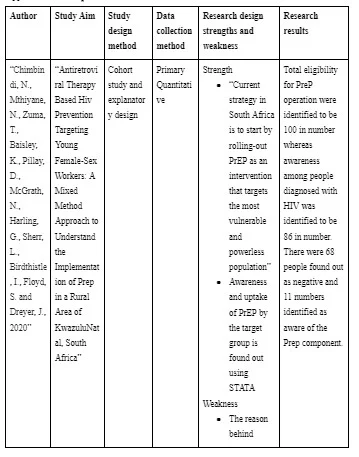
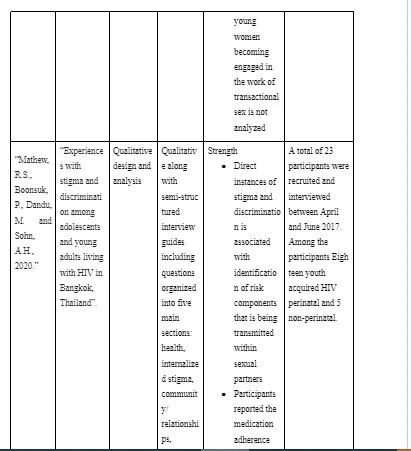
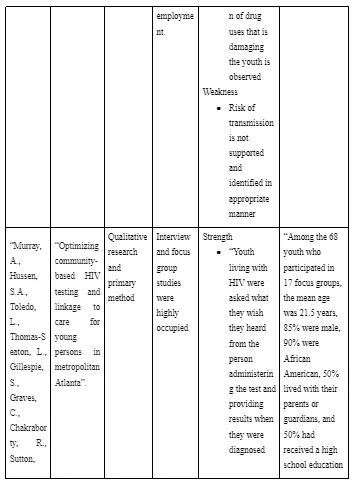
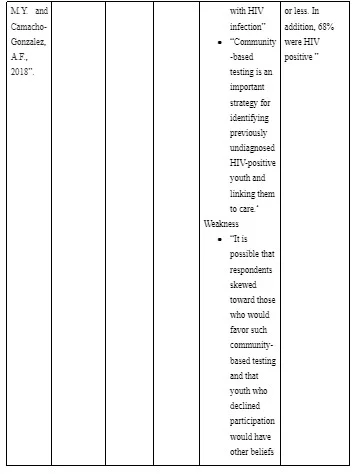
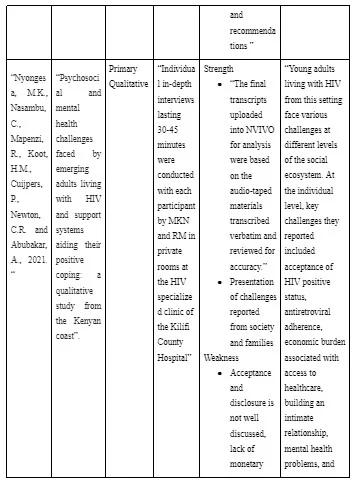
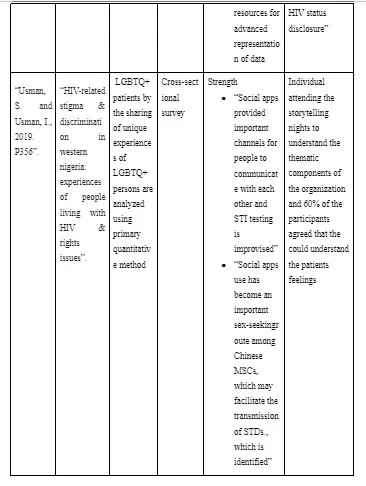
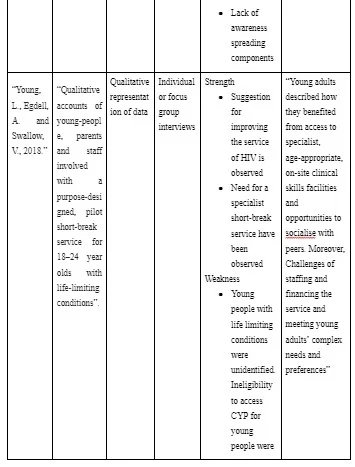
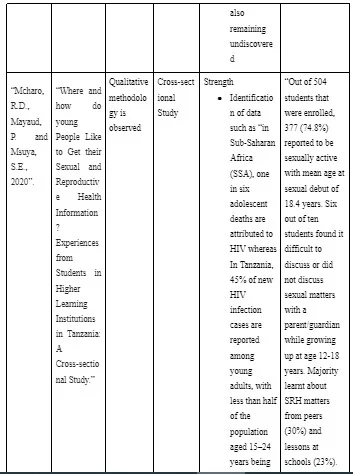
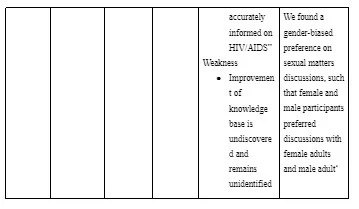
Appendix 2: Table 2
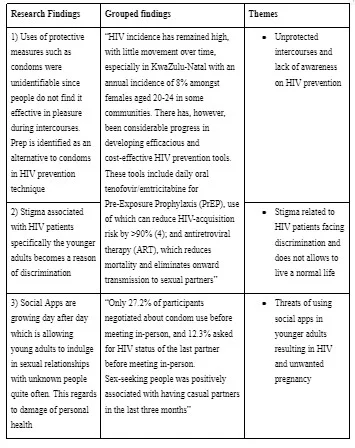
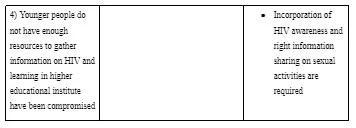
What Makes Us Unique
- 24/7 Customer Support
- 100% Customer Satisfaction
- No Privacy Violation
- Quick Services
- Subject Experts



